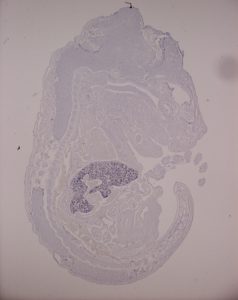Making enough red blood cells
EMBL scientists identify molecules that ensure red blood cell production

Red blood cells, the delivery men that take oxygen to cells all around the body, have short lives. To keep enough of them in circulation, the human body produces around 2 million of these cells every second – even more in response to challenges like severe blood loss. In a study published today in the Journal of Experimental Medicine, scientists at the European Molecular Biology Laboratory (EMBL) in Monterotondo, Italy, and EMBL’s European Bioinformatics Institute (EMBL-EBI) in Hinxton, UK, have identified two small RNA molecules which ensure that enough red blood cells are produced efficiently, by fine-tuning a number of different genes involved in this process.
“A lot of the effort of blood cell formation, or haematopoiesis, goes into just keeping enough red blood cells in circulation” says Dónal O’Carroll, who led the work at EMBL Monterotondo: “We’ve identified two molecules that help to do so, and which are essential in challenging situations.”
To form red blood cells, large, round cells known as precursors have to become small and disc-shaped, like balls of plasticine squeezed between finger and thumb. In the process, they must also produce the large quantities of haemoglobin that will allow them to transport oxygen, and shrink and dispose of their nucleus. The EMBL scientists found that two microRNAs, called MiR144 and MiR451, control the final stages of this process.
O’Carroll and colleagues genetically engineered mice to have no MiR144 or MiR451. They found that such mice had defects in the final stages of red blood cell formation, but produced red blood cell precursors not only in the bone marrow, but also in large quantities in the spleen. By increasing the number of precursors, the mice compensated for the fact that a smaller percentage of those precursors matured into functional red blood cells, and thus were able to survive with only a mild anaemia.
“Under steady-state conditions, mice without MiR144 or MiR451 can just about produce enough red blood cells, but if you challenge them, by chemically inducing anaemia, most of them don’t survive, because in those conditions you just can’t live with inefficient red blood cell formation” O’Carroll explains.
O’Carroll and colleagues teamed up with Anton Enright’s group at EMBL-EBI, and used a sophisticated bioinformatics approach to understand how these microRNAs act. They found that of the two, MiR451 probably plays a key role in the process, and that it likely does so not by switching a single gene on or off, but by fine-tuning a multitude of genes involved in red blood cell formation.
These microRNA molecules have been conserved throughout vertebrate evolution. They are known to also be important for red blood cell formation in fish, and are likely to play a similar role in humans too. Thus, investigating their function further could help to understand how our own red blood cells are formed, and how defects in that process may lead to conditions such as anaemia.



